Last Updated on December 8, 2024 by Kittredge Cherry
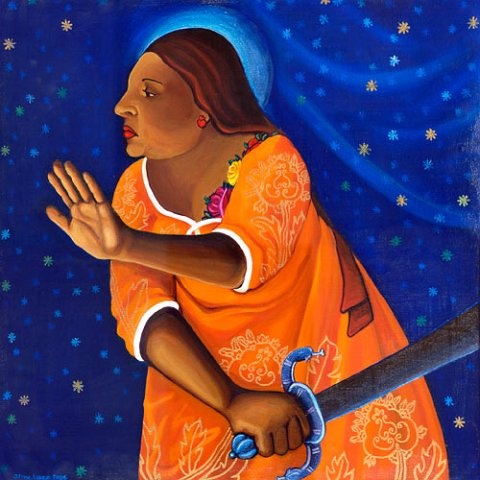
Our Lady of Guadalupe brings a message of holy empowerment that speaks to LGBTQ people — and angers Christian conservatives. Queer art based on Guadalupe is shown here for her feast day today (Dec. 12). She is an Aztec version of the Virgin Mary that appeared to Aztec peasant Juan Diego outside Mexico City on Dec. 12, 1531.
Even standard icons of Guadalupe are subversive because they show the Virgin as a dark-skinned Mexican, challenging the Euro-centric images of her as a blue-eyed white lady. The foremothers of the Mexican Guadalupe include the Black Madonnas, especially the medieval Spanish Our Lady of Guadalupe in Extremdaura, Spain. Guadalupe has become a powerful symbol, associated with everything from Mexican pride to motherhood, feminism and social justice.
Guadalupe first came in a vision
In Juan Diego’s vision, the dark-skinned Virgin of Guadalupe spoke to Juan Diego in Nahuatl, the Aztec language, addressing him as if he were a prince. It was astonishing because Mexico had been conquered 10 years earlier by Spaniards who claimed to have the one true faith. In his vision, Mary instructed him to fill his cloak or “tilma” with roses. Following her instructions, he gathered roses in his cloak. When he met with the bishop, he opened his cloak and the flowers fell to the floor, revealing the image of the Virgin of Guadalupe.
An icon of her, looking just as Juan Diego described, was imprinted on the cloak as a miraculous sign. Many scholars and indigenous activists believe that her name is a variant of Coatlaxopeuh, the Aztec serpent goddess. Our Lady of Guadalupe became a popular symbol of dignity and hope for the native people of Mexico, and by extension to indigenous or oppressed people everywhere.
The cloak is widely venerated and hangs above the high altar of the Guadalupe Basilica in Mexico City, the most-visited Catholic shrine in the world. As with Diana, that shrine to Mary is built where a goddess temple used to stand. The hill where Juan Diego had his vision used to be the site of an ancient temple to the Aztec mother goddess Tonantzin. Her temple was destroyed by the Spanish conquistadors. Our Lady of Guadalupe (in Spanish Nuestra Señora de Guadalupe or Virgen de Guadalupe) asked for a church to be built in her honor right there, among the conquered people. That shrine is now the most popular Catholic pilgrimage destination, receiving more than 6 million visitors per year.
 Lesbian visions of Guadalupe are described in the book “Chicana Sexuality and Gender: Cultural Refiguring in Literature, Oral History, and Art” by Debra J. Blake. She concludes, “In Chicano writings and artworks, Guadalupe becomes the site of female and lesbian desire.”
Lesbian visions of Guadalupe are described in the book “Chicana Sexuality and Gender: Cultural Refiguring in Literature, Oral History, and Art” by Debra J. Blake. She concludes, “In Chicano writings and artworks, Guadalupe becomes the site of female and lesbian desire.”
Artists look at Guadalupe
Those who took the liberating vision a step further to create queer Guadalupe art include Tony De Carlo, Alex Donis, Ralfka Gonzalez, Alma Lopez, and Jim Ru.
 |
| “Our Lady of Controversy” cover |
Erotically alive, feminist and lesbian versions of Our Lady of Guadalupe are a common theme in the art of Alma Lopez, a Chicana artist and activist born in Mexico and raised in California. A huge controversy erupted over her “Our Lady,” a digital print showing the Virgin of Guadalupe in a bikini made of roses, exalted by a bare-breasted butterfly. Lopez says she intended it as a tribute to Our Lady, “inspired by the experiences of many Chicanas and their complex relationship to La Virgen de Guadalupe.”
 |
| Encuentro (Encounter) by Alma Lopez |
Death threats, censorship efforts, and violent protests brought national and international attention to Lopez’ “Our Lady” over the years as artistic freedom clashed with freedom of religion. In one of the most recent conflicts, thousands of negative messages compromised the email system of an Irish university that dared to exhibit it in 2011. (For details, see my previous post Our Lady and Queer Saints art attacked as blasphemy – Show support now!).
 |
| “Lupe and Sirena in Love” by Alma Lopez |
In 2001 Catholic authorities tried to have Lopez’ “Our Lady” removed from an exhibition at the Museum of International Folk Art in Santa Fe. The debate is covered in the 2011 book “Our Lady of Controversy: Alma Lopez’s ‘Irreverent Apparition.’” from University of Texas Press. The anthology is edited by Alma Lopez and Alicia Gaspar de Alba. The two women were married in 2008, during the first brief period when same-sex marriage was legal in California.
“Our Lady” is erotic, but there is more overt lesbian content in some of the other images of Our Lady of Guadalupe that Lopez made. Her website, almalopez.com, includes images of a romance between Guadalupe and a mermaid in artwork such as “Lupe and Sirena in Love.”
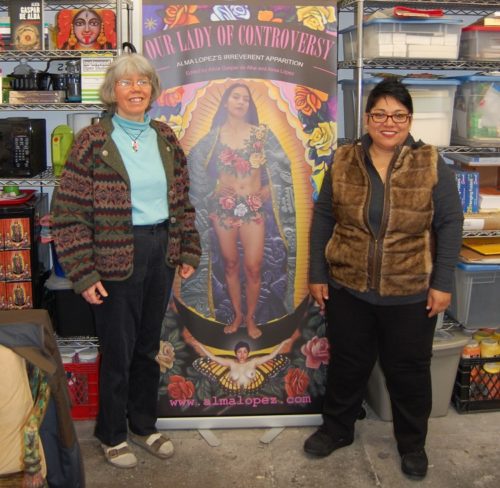
Q Spirit founder Kittredge Cherry, left, met artist Alma Lopez at her studio.
The Aztec moon goddess Coyolxauhqui has been interpreted as a lesbian deity by Chicanas such as writer-activist Cherrie Moraga. Lopez paints Coyolxauhqui, machete in hand, as Guadalupe in the image at the top of this post: “Coyolxauhqui Returns as Our Lady disguised as La Virgen de Guadalupe to defend the rights of Las Chicanas.”
The image also has a Biblical dimension. It appears to be based on “Judith and Her Maidservant with the Head of Holofernes” by Baroque painter Artemisia Gentileschi. In the Hebrew scriptures Judith heroically cuts off the head of an invading general.
Alex Donis painted the Virgin of Guadalupe kissing Mary Magdalene as part of “My Cathedral,” a series that showed people of opposite viewpoints kissing in same-sex pairs. Donis was familiar with contradictions from his own “tri-cultural” identity: pop, queer, and Latino. Born to Guatemalan parents, he grew up in East Los Angeles.
His “My Cathedral” exhibit caused a frenzy when it opened in San Francisco in 1997. Heated arguments erupted in the gallery, followed by threatening phone calls and letters. Vandals smashed two of the artworks: Jesus kissing the Hindu god Rama, and guerilla leader Che Guevara kissing labor organizer Cesar Chavez. Most people overlooked his painting of Guadalupe kissing Mary Magdalene, but it remains a potent, beautiful expression of the union of sexuality and spirituality. It is included in the book “Art That Dares: Gay Jesus, Woman Christ, and More by Kittredge Cherry..”
Artist Tony de Carlo affirms the holiness of gay love with bright, festive paintings of queer saints, Adam and Steve, same-sex marriage and much more. His genderbending “Chulo De Guadalupe” appears to show Mary as male, intersex or transgender. In Mexican slang “chulo” refers to someone who is cute and, in some cases, sexy.
De Carlo, who died in 2014, was a native of Los Angeles. His work is exhibited regularly in museums and galleries throughout the United States.For more on Tony De Carlo and his art, see my previous post: Gay saints, Adam and Steve, and marriage equality art affirm LGBT love: Tony De Carlo Interview.
 |
| “Virginia Guadalupe” by Jim Ru |
Jim Ru painted a bearded drag queen version of the Virgin of Guadalupe. Titled “Virginia Guadalupe,” the painting was displayed in his show “Transcendent Faith: Gay, Lesbian and Transgendered Saints” in Bisbee Arizona in the 1990s. He discusses it in a 2015 video.
Outsider artist Ralfka Gonzalez adds an androgynous Buddhist interpretation by painting Guadalupe as the embodiment of compassion known as Chenrezig, Avalokiteshvara or Kwan Yin. Tradition says the compassionate bodhisattva is both male and female. In the Gonzalez image, he/she is wrapped in Juan Diego’s cloak.
Pictured here is the first of many “Buddha Lupe” images painted by Gonzalez. He is a self-taught Chicano artist and gay Latino activist who divides his time between Oaxaca, Mexico and San Francisco. He often paints Mexican and/or gay themes in a colorful folk-art style.
These bold paintings certainly give new meaning to the title bestowed upon Guadalupe by Pope Pius XII: “Queen of Mexico.” If the Virgin Mary could appear to an Aztec as an Aztec, then why not show up to a queer as a queer?
Guadalupe tends to dominate discussions of Latinx depictions of Mary, but other icons of the Virgin tend to be more important outside Mexico, such Our Lady of Lujan in Argentina. And artists are making queer versions of these other Virgins too. For example, Giuseppe Campuzano (1969-2013) of Peru cross-dressed as Our Lady of Sorrows in art portraits that appear in his book “Museo Travesti del Peru (The Peruvian Transgender Museum).”
Rainbow Our Lady of Guadalupe
Rainbow icons of Mary highlight her compassionate connection to the LGBTQ community. They are a cross-cultural phenomenon, including Guadalupe and many other visions of Mary. “Rainbow Pride Guadalupe” appears on T-shirts from the Modern Maya Design on Etsy. She shines with rainbow rays in the pride image.
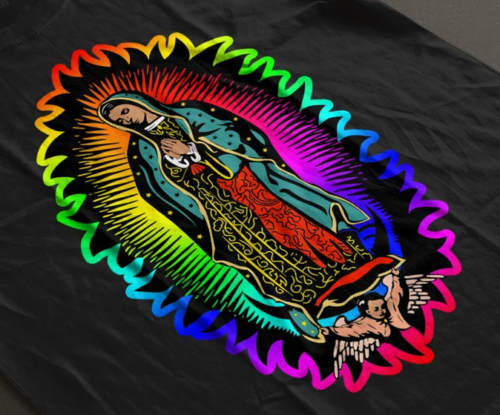
“Rainbow Pride Guadalupe” by the Modern Maya Design Etsy shop
Links related to the Virgin of Guadalupe
A Visit to Alma Lopez’ Studio: Finding lesbian saints, mermaids, revolutionaries and goddesses (Jesus in Love)
Our Lady of Guadalupe: Patroness of LGBTQ and Other Outcast People by Sarah Gregory (New Ways Ministry)
Gloria Anzaldúa: Queer feminist Chicana scholar of spiritual activism (Q Spirit)
To read this post en español, go to Santos Queer:
La Virgen de Guadalupe Queer: Artistas reinventan un icono
Q Spirit articles related to Mary as a queer liberator
Rainbow Mary: LGBTQ-affirming rainbow Mary art sparks protests and celebrations
“Mary, Queer Liberator” prayer: We your queer children call on you
Madonna of Montevergine: Patron of LGBTQ people since medieval times
Black Madonna of Czestochowa becomes lesbian defender Erzuli Dantor
Queer Lady of Guadalupe: Artists re-imagine an icon
Advent: Lesbian Mary’s virgin birth
Support Polish LGBTQ activist arrested for rainbow Virgin Mary posters
Mary, Diana and Artemis: Feast of Assumption has lesbian goddess roots
Books with liberating views of Mary
“Mother of God Similar to Fire” with icons by William Hart McNichols and reflections by Mirabai Starr presents a wide of variety of liberating icons of Mary, including a black Madonna. McNichols is a New Mexico artist and Catholic priest who has been rebuked by church leaders for making icons of LGBT-affirming martyrs and saints not approved by the church.
“Goddess and God in the World: Conversations in Embodied Theology” by Carol P. Christ and Judith Plaskow. Two pioneering leaders in the study of women and religion discuss the nature of God / Goddess.
“Alone of All Her Sex: The Myth and the Cult of the Virgin Mary” by cultural historian Marina Warner shows how the figure of Mary was shaped by goddess legends and other historical circumstances, resulting in an inferior status for women.
“Holiness and the Feminine Spirit: The Art of Janet McKenzie,” edited by Susan Perry, includes many black Madonnas in an art book to nourish devotion to Mary with reflections by diverse women.
“Unlocking Orthodoxies for Inclusive Theologies: Queer Alternatives” includes the chapter “Nahum Zenil: ‘the Virgin Mary became my mother’” by Justin Sabia-Tanis. It discusses Mary in the radically queer Catholic piety of gay Mexican artist Nahum Zenil.
“Sing of Mary: Giving Voice to Marian Theology and Devotion” by Stephanie Budwey. The focus of the book is about hymns to Mary but the last chapter includes a discussion of how Mary can be liberating, including to LGBTQ people.
___
Top image credit: “Coyolxauhqui Returns as Our Lady disguised as La Virgen de Guadalupe to defend the rights of Las Chicanas” by Alma Lopez
This post is part of the LGBTQ Saints series by Kittredge Cherry. Traditional and alternative saints, people in the Bible, LGBTQ martyrs, authors, theologians, religious leaders, artists, deities and other figures of special interest to lesbian, gay, bisexual and transgender and queer (LGBTQ) people and our allies are covered.
This article was originally published on Q Spirit in December 2016, was expanded with new material over time, and was most recently updated on Dec. 11, 2023.
Copyright © Kittredge Cherry. All rights reserved.
Qspirit.net presents the Jesus in Love Blog on LGBTQ spirituality.






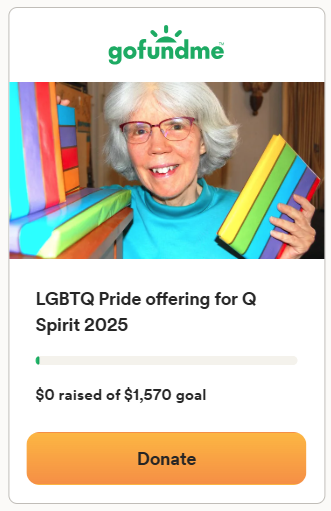
















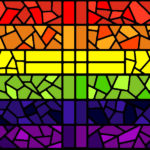

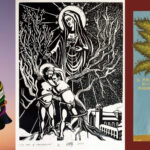

You claim “Our Lady of Guadalupe brings a message of holy empowerment that speaks to LGBTQ people — and angers Christian conservatives” – which is nonsense given that so many conservative Catholics venerate Our Lady of Guadalupe, and Juan Diego was officially made a saint. The thing that DOES anger many people – and not just conservatives – is the practice of sexualizing and hijacking this figure by depicting her as a scantily-clad sex object and/or lesbian. The irony is that every feminist would get angry if one of their feminist heroines was portrayed as a sex object or stereotyped as a lesbian just for being a feminist.
You clearly don’t understand that freedom of sexuality, whether this be abstinence, queer freedom, or otherwise – is an integral part of feminism. A nude body is not inherently sexual – your own prejudice and preconceived views have sexualised this woman’s nude body, you have objectified this figure. Our Lady of Guadalupe has not been stereotyped as a lesbian for being feminist – this is the artists artistic expression as she is a queer feminist woman. As a staunch feminist I love this piece of art.
This is a reply to Kate Standen since the system doesn’t allow a direct reply. If a nude woman isn’t “sexualized” then why do men spend so much time gawking at nude women on porn websites? More to the point, depicting the Virgin Mary this way is especially offensive for reasons that should be obvious even to a “staunch feminist” (in fact especially to a staunch feminist).
I need these kind of icons for chapel second row
I have the traditional 12!great feasts I want a gay themed second rowbgay themed but liturgically conservative for the Chapel which is one of the few Byzantine chapels got gay Christians
This is fantastic!
As a part of my presentation, I plan to share the stories of 4-5 queer people and their experiences with crossing the border and being placed in detention prisons and then juxtaposing them with queered images of La Virgen. (Well, that’s the idea…) We actually studied some of Lopez’ art in Dr. Tanis’ class and when I saw some of these presented with others I have not seen, I was pretty excited. So, particularly because some of our texts for the class talk about the myths and tales of Coyolxauhqui and La LLorona (!), I was hopeful that the image at the top was “queered” at least somewhat. Thank you for the information!
Hi there. I’m a recent PSR graduate (and mentee of Rev. Jim Mitulski) working on a presentation for my Border Immersion to Tijuana next week. I am doing research on the particular dangers of queer migrants, particularly trans women and as a part of that, am working on a prayer for Queer Migrants. I ran across this post looking for queer icons of the Virgen de Guadalupe, some of which we studied in Rev. Dr. Justin Tanis’ PSR class “Sexuality and Sacred Art.” I am curious about the image at the top of this post. Is she queer or an example of a subversive, dark-skinned Lady? Who is the artist? Thank you for this post which I will most certainly cite. Blessings and thank you for your body of work and example of an activist, queer, theologian! (And PSR alum!)
The image at the top of this post is “Coyolxauhqui Returns as Our Lady disguised as La Virgen de Guadalupe to defend the rights of Las Chicanas” by Alma Lopez. The Aztec moon goddess Coyolxauhqui has been interpreted as a lesbian deity by Chicanas such as writer-activist Cherrie Moraga. While this top image may be open to multiple interpretations, Alma has done some other artwork where Guadalupe’s lesbian love is more explicit, such as “Lupe and Sirena in Love” shown here in my article.
Thank you for citing my article, and best wishes for your Border Immersion and queer migrants prayer. It’s great to connect with another PSR grad who shares connections to people who have had a big impact on my spiritual development.